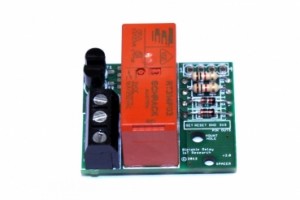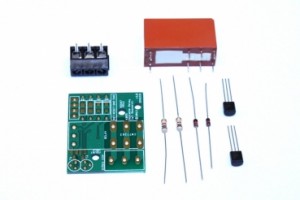Latching relays keep their switch contact direction without power, this makes them very suitable for low power situations such as batteries or where permanent power is undesired. The best way to imagine a latching relay is a light switch, you briefly push it to turn on, it remains that way with no power until you push it to turn off. Normal relays require a continuous voltage to keep the contacts closed, bistable versions do not.
Keeps contacts set either on/off without requiring power (means much lower power consumption)
Twin 3v DC coils are buffered by driver transistors (requires very little current to drive the coils, makes it suitable for micro-controller or TTL control)
Can be used at up to 5v (as the contacts require only a brief pulse, they will tolerate 5v)
Very high quality Shrack relay (means long life and reliability)
SPDT relay (sometimes called single pole change over)
16Amp switching at up to 250v AC (switch high current AC or DC loads)
Features:
Gold plated finish (Protection against oxidization means your device will outlast normal HASL boards)
Comes as a complete "self solder" kit of parts
Easy large pads to solder connections to
Easy to add a standard header connector if desired
We can prebuild on orders over 10, there will be a cost and time associated with this, please phone or email to discuss
Made in the UK
Technical data:
Dimensions: 35.5 mm x 29.4 mm x 19.4 mm
Connections: are on standard 0.1"/2.54mm spaced holes (left to right as in picture, zoom shows in better detail). You connect PWR and GND to your power source (eg battery) and then briefly (between 1/10th and 1/2 a second is recommended) put a voltage between 2.5 and 12v into either the SET and RESET pins to flip the relays internal 16A switched contacts in either direction. After the pulse the relay will remain in that position until a pulse on the other pin flips it back.
1 - SET - Pulsed input (from a PC/micro/TTL etc) 3v to 5v
2 - RESET - Pulsed input (from a PC/micro/TTL etc) 3v to 5v
3 - GND - Ground or minus on a battery
4 - PWR - 3 to 5v power or positive on a battery
N.B. - When using voltages over 3v never hold SET or RESET for longer than 1/2 second
Keeps contacts set either on/off without requiring power (means much lower power consumption)
Twin 3v DC coils are buffered by driver transistors (requires very little current to drive the coils, makes it suitable for micro-controller or TTL control)
Can be used at up to 5v (as the contacts require only a brief pulse, they will tolerate 5v)
Very high quality Shrack relay (means long life and reliability)
SPDT relay (sometimes called single pole change over)
16Amp switching at up to 250v AC (switch high current AC or DC loads)
Features:
Gold plated finish (Protection against oxidization means your device will outlast normal HASL boards)
Comes as a complete "self solder" kit of parts
Easy large pads to solder connections to
Easy to add a standard header connector if desired
We can prebuild on orders over 10, there will be a cost and time associated with this, please phone or email to discuss
Made in the UK
Technical data:
Dimensions: 35.5 mm x 29.4 mm x 19.4 mm
Connections: are on standard 0.1"/2.54mm spaced holes (left to right as in picture, zoom shows in better detail). You connect PWR and GND to your power source (eg battery) and then briefly (between 1/10th and 1/2 a second is recommended) put a voltage between 2.5 and 12v into either the SET and RESET pins to flip the relays internal 16A switched contacts in either direction. After the pulse the relay will remain in that position until a pulse on the other pin flips it back.
1 - SET - Pulsed input (from a PC/micro/TTL etc) 3v to 5v
2 - RESET - Pulsed input (from a PC/micro/TTL etc) 3v to 5v
3 - GND - Ground or minus on a battery
4 - PWR - 3 to 5v power or positive on a battery
N.B. - When using voltages over 3v never hold SET or RESET for longer than 1/2 second
No projects use this part yet.
Attributes
| Schaltspannung: | 250VAC | |
| Schaltstrom: | 16A | |
| Spannung: | 3-5V |
Info
| Best Price | 7.14 € | ||
| Best Bulk Price | 7.14 € | ||
| Friends Stock | 0 | ||
| Overall Stock | 0 | ||
| Login to add to stock | |||
| 0 Projects use this part. | |||
| Created: | 2013-07-20 09:09:00 | ||
| Last Update: | 2013-10-20 11:02:19 | ||

